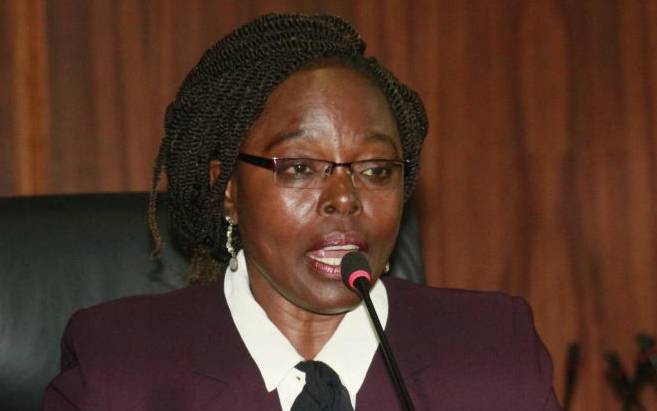AfricaPress-Kenya: Counties may have failed to implement some key projects in the last financial year which ended on June 30, after the devolved units lost about Sh19 billion in projected local revenue during the 2019/2020 financial year.
According to a report released by the Controller of Budget Margaret Nyakang’o (pictured above), counties collected only Sh35.7 billion against a projection of Sh54.9 billion during the period under review.
The revenues had been expected to help complement some Sh316.5 billion equitable share received from the national government as well as donations and grants from donors to help finance projects and activities.
The figure also reflected a drop of about Sh4.5 billion from the Sh40.3 billion that was collected by counties during the 2018/2019 financial year.
The statistics highlight the gaping hole the pandemic has left on the economy even as counties continue to grapple with huge pending bills and several stalled projects, some of which may not be completed before the next polls.
And with the revelations, questions remain whether counties will be able to bridge the gap in revenue shortfall in this financial year as time and Covid-19 remain the thorn in the flesh for counties.
Only five out of the 47 counties managed to defy odds brought by Covid-19 as well as other challenges to meet their revenue targets.
They include Homa Bay (Sh118 million), Taita Taveta (Sh296 million), Machakos (Sh1.3 billion), Lamu (Sh108 million) and Bomet (Sh201 million).
Most of the counties had been hoping to improve their revenues in the last quarter of the financial year before Covid-19 struck and halted those plans.
The report captured the period between July 2019 to June 2020.
The COB attributed the drop in locally generated revenue to the Covid-19 pandemic which has affected several operations in counties with a number of them still struggling to find a footing.
“This underperformance of own-source revenue collection was, partly, as a result of economic disruptions occasioned by actions taken by the government to contain the spread of the Covid-19 Pandemic which impacted all sectors of the economy,” said Nyakang’o.
The report titled, “County Governments Budget Implementation Review Report for the FY 2019/20” indicates that drops in revenues impacts negatively on budget implementation.
Despite the low generation of local revenue, the COB has also faulted some counties of weak budget controls that has seen some counties even spend locally collected revenue at source.
During the period under review, Nairobi County continued with its dominance in the generation of local revenue by recording Sh8.7 billion in locally generated revenue. The county had projected to raise about Sh17 billion with its collection only half of its projections.
In the past financial years, Nairobi has been the highest locally revenue generator and has also been topping the list of counties with huge allocations from the national government.
Other counties that also generated high revenue despite not reaching their revenue targets included Mombasa and Nakuru counties which collected Sh3.2 billion and Sh2.55 billion respectively.
According to Nyakang’o, some seven counties to fail to generate even half their targets and recorded figures below 50 percent.
The counties include Meru, Nandi, Busia, Siaya, Wajir, Kajiado, and Kisii which struggled to improve their revenues in the last financial year even though they were not the worst perfoming counties.
The report indicates that counties that generated the lowest revenues included West Pokot, (Sh107 million), Tana River (Sh64.4 million) and Wajir (Sh60.4 million).
This comes even as the COB also faulted counties for underutilizing development expenditure despite receiving money from the national government and from grants.
According to the COB, counties spent Sh104.5 billion on development against a budget of Sh187 billion. This means that about Sh82 billion meant for implementing development projects was not utilized.
Analysis of development expenditure indicates that Murang’a, Isiolo, Mandera and Marsabit Counties attained the highest absorption rates at 85.7 per cent, 79.7 per cent, 79.7 per cent and 79 per cent respectively.
Several other counties, however, failed to properly utilize their development funds which is an indication that some projects that had been planned for the financial year were not completed.
Although the failure to absorb the funds can be blamed on Covid-19 which paralyzed activities, several projects continue to lie abandoned in several counties with some already in ruins.
In Nyanza for instance, a number of projects have been abandoned by contractors with some dating back to the 2014/2015 financial year.
The projects include dispensaries, early childhood education centres, roads, resource centres, colleges and Huduma centres.
Although some of the projects were not included in the 2019/2020 budget, reports by the COB indicates that funds to implement development projects were available but counties underutilised them.






